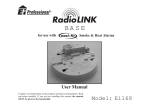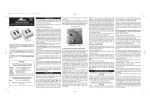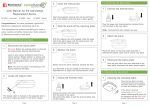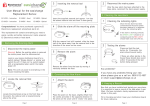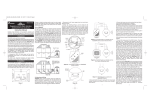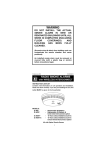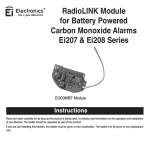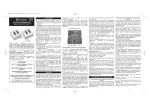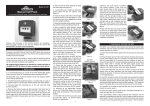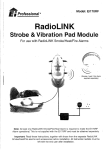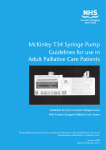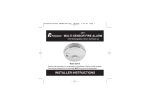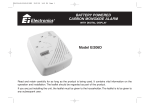Download Ei Electronics Ei 411 User's Manual
Transcript
Model: Ei 411 Remote Control AMBER LIGHT Contains vital information on the products operation and installation. Read and retain carefully. If you are just installing this product the manual MUST be given to the householder. 1. INTRODUCTION The Ei 411 Remote Control allows you, without the use of ladders or chairs, to: • test the smoke alarms. • locate the smoke/heat alarm sensing fire by silencing all the other alarms (for 10 minutes). This is of great benefit, particularly at night as the source of the fire can be quickly traced audibly. This is ideal for larger systems as people nearest the fire can be quickly evacuated and/or the fire controlled if it is small. (The Locate button also identifies which alarms have previously sensed fire. This is very useful when trouble-shooting systems of many smoke and/or heat alarms see section 4 - Alarm Memory Function). Silencing Nuisance Alarms Nuisance alarms can be silenced by turning the test button on and then off only with the following RadioLink Smoke Alarm: Ei405, Ei405TY, Ei161R on an Ei168 base and an Ei166R on an Ei168 base. If there is a fire, immediately evacuate the premises and telephone the fire brigade from outside. Do not silence the unit unless you are sure there is no fire. 2. INSTALLATION 1. Position the Ei411 Remote Control (approx) 1.2 metres up on a wall in a suitable position on an exit route. Avoid locating near metal objects. 2. Securely attach the mounting base of the unit to the wall using the fixing screws supplied. 3. Carefully slide the battery switch into the ‘on’ position (see figure 1). The amber light will flash once. ON/OFF Switch a) Place all the RadioLINK smoke/heat alarms and accessories into house code mode, within 15 minutes, as described in their instruction leaflets. b) Also, within the same 15 minutes, place the Ei411 Remote Control into house code mode by pressing and holding the house code button until the amber light turns on. Release the button and the amber light will now House Code Button flash continuously (for 15 minFigure 1 utes) to show it is in house code mode (Note: The Remote Control flashing amber light does not indicate the number of units in the system. It just flashes rapidly to show it is in house code mode. The Ei411 is only an RF transmitter and does not receive any RF signals). c) The Remote Control will now send a radio message every 5 seconds to indicate it is in house code mode. All smoke/heat alarms and accessories within range that are also in house code mode themselves, will memorise the house code of the Remote Control. d) Check that the number of blue light flashes (for RadioLINK Smoke Alarms) or amber light flashes (for RadioLINK Bases) correspond with the number of units in the system (e.g. smoke alarms plus the Remote Control). For example, with 3 RadioLINK smoke alarms and one Remote Control you should see 4 blue light flashes from each alarm. e) Remove all the RadioLINK smoke/heat alarms, RadioLINK bases and other accessories from house code mode as described in their instruction leaflets. f) The Remote Control will exit the house code mode by itself after approximately 15 minutes without further user intervention. However, this could result in problems with nearby systems, if their units are being house coded at the same time. If this is the case remove the Remote Control from its mounting plate and then from house code mode by pressing and holding the code button until the amber light comes on (i.e. use the same method as to enter house code mode). Release the button and the amber light will go out, indicating that the Remote Control has exited house code mode. Re-assemble and attach to box as described above. g) Using the test button, verify that the Remote Control activates all the alarms in the system. (If some or all of the alarms have not been activated, then the house coding procedure should be repeated. If there are still some problems, see the section 5 on “Troubleshooting”.) 2 Clearing the House Codes: It may sometimes be necessary to clear the House Codes. (e.g. if you wanted to use the Remote Control with different alarms). To clear the house codes: To House Code your Remote Control: For use with RadioLINK range of Smoke / Heat Alarms and Bases 1 4. It is essential that you house code your Remote Control with your smoke/heat alarms and any RadioLINK accessories to prevent false alarms and other interference with nearby systems (see below). • Unscrew the cover plate from the mounting box. • Press and hold the house code button for over 6 seconds until the amber light turns on continuously and then flashes slowly. Now release the button and the amber light will go out. • then re-attach to the mounting box. Note clearing the house codes will now reset the Remote Control to the original factory setting. It will now only communicate with un-coded alarms (see Smoke Alarm instruction leaflet for information on how to un-code the smoke alarms). 3. USING REMOTE CONTROL EI 411 The Remote Control Ei 411 allows you to Test or Locate units as follows:Test / Manual Alarm Switch – use to test the smoke/heat alarms or bases weekly. Switch the Test button on. The amber light comes on for 3 seconds to indicate it is transmitting an RF signal. (The amber light will continue to flash once every 5 seconds while the test button switch remains on) Then: • the RadioLINK Smoke Alarms (Ei 405 and Ei 405TY) will alarm in 10 seconds, with the red light on the smoke alarm flashing rapidly. (This indicates that the chamber has been tested in exactly the same way as if the test button of the alarm itself had been pressed. The alarm will also now be in Hush mode for the next 10 minutes). • with an Ei 161R or Ei 166R on an Ei 168 RadioLINK Base, the red light on the smoke alarm will flash rapidly. (This indicates that the chamber has been tested in exactly the same way as if the test button of the alarm itself had been pressed. The alarm will also now be in Hush mode for the next 10 minutes). • with a mains Smoke Alarm (Ei161, 166, 164, 141, 144, 146) on an Ei 168 RadioLINK Base the alarm will sound indicating the RF receiver, electronics and horn are operational. Switch the Test button off. The amber light comes on again for a further 3 seconds to indicate transmission of the alarm cancel signal. (Note: After 5 minutes the Remote Control will stop sending RF alarm signals and therefore the smoke alarms will stop sounding. This prevents the batteries in the Remote Control and in the smoke alarms being depleted). Locate Switch – primarily used to identify the smoke/heat alarm sensing fire. Press and release the momentary Locate Button on. The amber light comes on continuously for 3 seconds to indicate it is transmitting an RF signal. (If the Locate button is held on, the RF signal will continue to be transmitted every 5 seconds and the amber light will flash). If all the smoke alarms (either RadioLINK Alarms or Bases with Easifit alarms attached) are in alarm due to one alarm sensing smoke, pressing the Locate button on the Remote Control, will silence all the alarms except those sensing fire. 3 This is a very useful feature. For example, consider twelve alarms sounding simultaneously, then the unit sensing the fire can be quickly identified audibly and the problem quickly resolved. What to do when the Alarms go off 1.If there is a fire, immediately evacuate the premises and telephone the fire brigade from outside. 2. When the alarms go off and the cause is not obvious, immediately press the “Locate” switch. This will silence all the alarms except those sensing fire themselves. 3. Locate the alarm(s) sensing fire audibly. Be careful, check doors are not warm and that there is no sign of smoke before you open them. (See escape plan in Smoke Alarm instructions for further details). 4. If you are fully satisfied that there is no fire, but the smoke/heat alarm is still continuing to alarm with its red light flashing quickly,, then remove the unit from its mounting and disconnect the power. 4. ALARM MEMORY FUNCTION Using the Locate button on the Remote Control it is possible to identify which alarms have previously sensed fire (i.e. been in alarm). This is of great benefit in systems with 3 or more units when trying to identify the source of alarm from some time previously. To use the alarm memory function: 1. Reset the memory by pressing the Test button on the Remote Control until all the units have alarmed. (This must be done if any of the RadioLINK units have been in alarm and whenever any of the Easi-fit alarms on the Ei168 RadioLINK bases have been button tested). 2. Any unit now sensing fire will alarm and the memory function will record this event. 3. To identify which units have previously alarmed press the Locate button on the Remote Control. The units, which have previously sensed fire, will sound briefly. This is particularly useful in tracking down the case of nuisance alarms such as cooking fumes, steam from bathrooms or defective/contaminated alarms . 4. Finally reset the alarms sounding by pressing the Test Button on the Remote Control. 5. TROUBLESHOOTING RF LINK If, when checking the radio link interconnection, some of the alarms do not respond to the Remote Control test, then: (i) Ensure the Ei 411 Remote Control has been activated correctly and the amber light has come on continuously for 3 seconds (with the test button in the ‘ON’ position) and then continues to flash amber for 5 minutes). (ii) Repeat house code procedure (see section 2). (iii) Convert one of the RadioLINK Bases or alarms that is centrally located within the house to be a “Repeater” (see their relevant user instructions ) 4 (iv) Re-locate the Remote Control and/or rotate/re-locate the RadioLink units. There are a number of reasons why the radio link signals may not reach all the smoke alarms in your system (see section 6 on “Limitations of Radio Frequency Signals”). Try rotating the units or re-locating the units (e.g. move them away from metal surfaces or wiring) as this can significantly improve signal reception. dim or fails to turn on, the battery in the unit is probably depleted. (Excess use of the switch can shorten battery life). Rotating and/or relocating the units may move them out of the range of existing units even though they may have already been house coded correctly in the system. It is important therefore to check that all detectors are communicating in their final installed positions. If units are rotated and/or resited, we recommend that all units are returned to the factory settings (see the respective use and care instructions). Then house code all units again in their final positions. The radio link interconnection should then be checked again. 8. GETTING YOUR REMOTE CONTROL SERVICED The Ei411 must be switched off before disposing/recycling in accordance with the directive 2002/96/EC on waste electrical & electronic equipment (WEEE). If your Remote Control fails to work after you have read this leaflet contact Customer Assistance at the nearest address given at the end of this leaflet. If it needs to be returned for repair or replacement put it in a padded box with the battery disconnected. Send it to "Customer Assistance and Information" at the nearest address given on Remote Control or in this leaflet. State the nature of the fault, where Remote Control was purchased and the date of purchase. 6. LIMITATIONS OF RADIO COMMUNICATIONS Ei Electronics radio communication systems are very reliable and are tested to high standards. However, due to their low transmitting power and limited range (required by regulatory bodies) there are some limitations to be considered: (i) Radio transceiver equipment, such as the Ei411 Remote Control, should be tested regularly at least weekly. This is to determine whether there are sources of interference preventing communication. The radio paths may be disrupted by moving furniture or renovations, and so regular testing protects against these and other faults. (ii) Receivers may be blocked by radio signals occurring on or near their operating frequencies, regardless of the house coding. The Ei 411 Transceiver has been tested to EN 300 220-1 V1.3.1 (200-09) in accordance with the requirements of EN 300 220V1.1.1 (2000-09). These tests are designed to provide reasonable protection against harmful interference in residential installations. This equipment generates, uses and can radiate radio frequency energy and, if not installed and used in accordance with the instructions, may cause harmful interference to radio and television reception. However, there is no guarantee that interference will not occur in a particular installation. Interference from the Smoke Alarm system can be identified by turning the whole system off. See figure 1 for this unit. Refer to the instructions supplied with the other products used for information on these. The user is encouraged to eliminate the interference by one or more of the following measures: (i) Re-locate the unit (ii) Increase the distance between the Ei 411 and the device being affected. (iii) Consult the supplier or an experienced radio/television technician. 7. END OF LIFE The Ei411 Remote Control is designed to last 10 years in normal use. However the unit must be replaced if: 1. The unit is over 10 years old (see ‘replace by” label on the side of the mounting box). 2. If the test switch fails to operate the alarms, or the amber light looks 5 Note: It may be necessary, sometimes, to return a smoke alarm or other RadioLINK accessories (see their instruction leaflet) along with the Remote Control, if you cannot establish which is faulty. 9. FIVE YEAR GUARANTEE (LIMITED) Ei Electronics guarantees this product against any defects that are due to faulty material or workmanship for a five year period after the original date of consumer purchase or receipt as a gift. This guarantee only applies to normal conditions of use and service, and does not include damage resulting from accident, neglect, misuse unauthorized dismantling or contamination howsoever caused. Excessive use of the switch will shorten the battery life and is not covered. If this product has become defective it must be returned to Ei Electronics (see "Getting Your Remote Control Serviced") with proof of purchase. If the product has become defective during the five year guarantee the manufacturer will repair the unit without charge. This guarantee excludes incidental and consequential damages. Do not interfere with the product or attempt to tamper with it. This will invalidate the guarantee. Aico Ltd Mile End Business Park, Maesbury Road, Oswestry, Shropshire SY10 8NN, U.K. Telephone: 0870 7584000 www.aico.co.uk Ei Electronics Shannon Industrial Estate, Shannon, Co. Clare, Ireland. Telephone: +353 61 471277 www.eielectronics.com P/N A15266 Rev 0 © Ei Electronics 2004 6



